Interview: Metallica's James Hetfield and Kirk Hammett on their tonal evolution, the art of the riff and justice for Lars
Metal legends talk Hardwired... To Self-Destruct, guitars and back catalogue
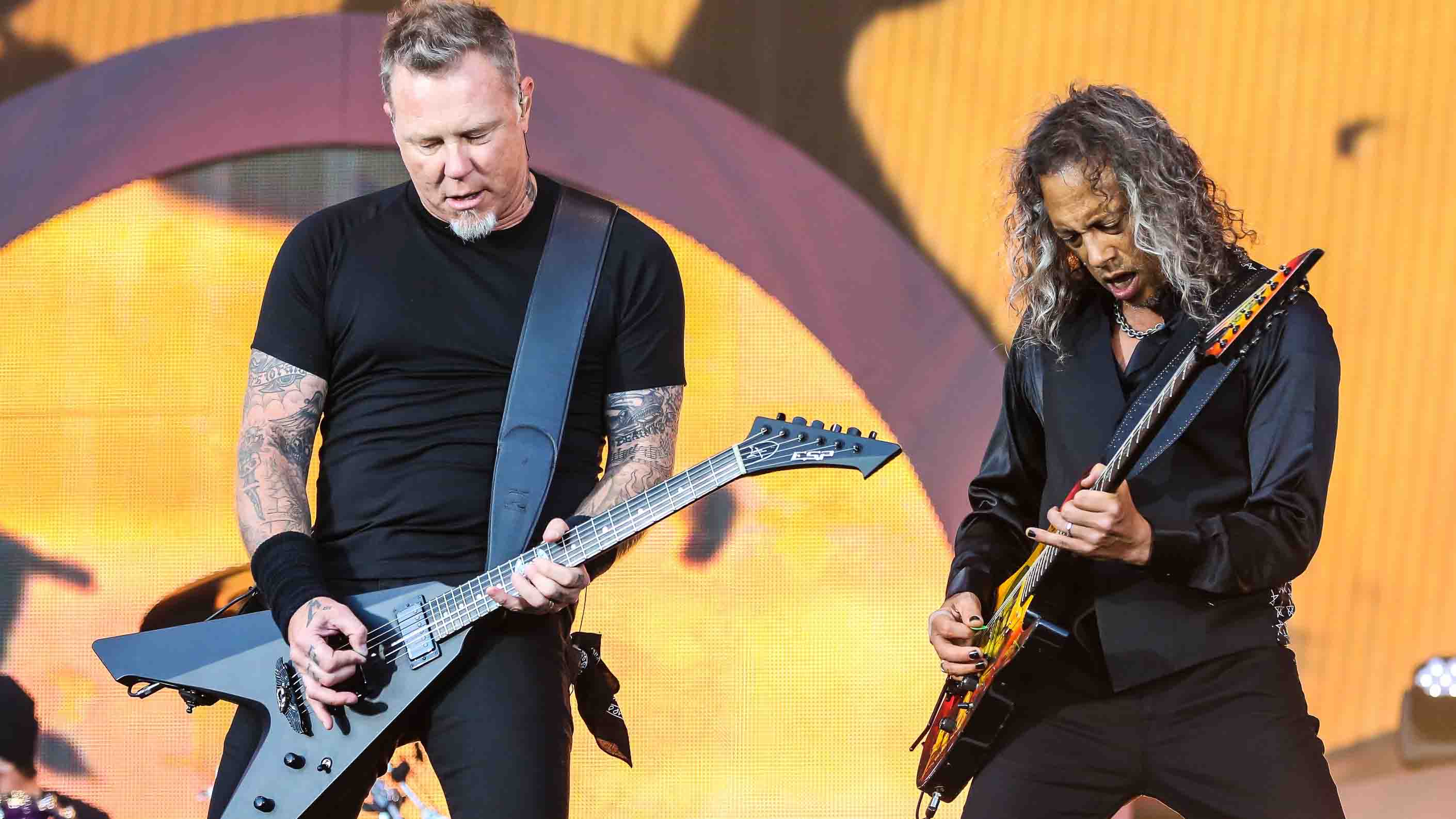
Introduction
Metallica’s new album proves that the biggest metal band in the world aren’t planning to vacate their throne any time soon. We talk digging in, breaking out and getting groovy again with James Hetfield and Kirk Hammett…
We all have opinions on Metallica - Lulu, Lars, Load, Kirk’s wah, Some Kind Of Monster… that snare sound on St Anger. It’s difficult to get two people to even agree on what their defining album is.
James Hetfield and Kirk Hammett helped raise the standard for heavy metal to a place nobody else has yet climbed
And therein lies their greatest gift, the quality that has made them an obsessive rite of passage for us guitarists inspired to pick out Fade To Black, headbang along to that Enter Sandman riff and grimace in bedrooms trying to nail the physically punishing downpicking in Master Of Puppets.
As players, composers and live performers James Hetfield and Kirk Hammett helped raise the standard for heavy metal to a place nobody else has climbed yet. They’ve transcended the genre; they headlined Glastonbury and your nan knows their name. And still a lot of people have been wondering what band is going to take on the torch from them.
Well, it turns out they’re not done with it. Eight years after Death Magnetic, they have an album that is going to surprise people. If you always believed they could, or if you’ve felt burned, disillusioned, or you just think they’ve given more than enough to metal already, Hardwired… To Self Destruct is for you.
This isn’t hyperbole - Metallica have got their 90s groove back on easily their best record since The Black Album. And as an 80-minute double-album of music written primarily by the nucleus of Hetfield and Lars Ulrich, it sees Hammett changing tack, too.
“Metallica is a collaborative process,” Kirk tells us. “Even though James and Lars do the lion’s share of songwriting, we’re all here to help each other make the best album that we possibly can.” Okay, Mr Hammett, Mr Hetfield… let’s talk guitar.
Don't Miss
Dave Mustaine reviews Metallica's Hardwired… To Self-Destruct
Kirk Hammett on owning Peter Green's 1959 Gibson Les Paul: "It just blew me away"
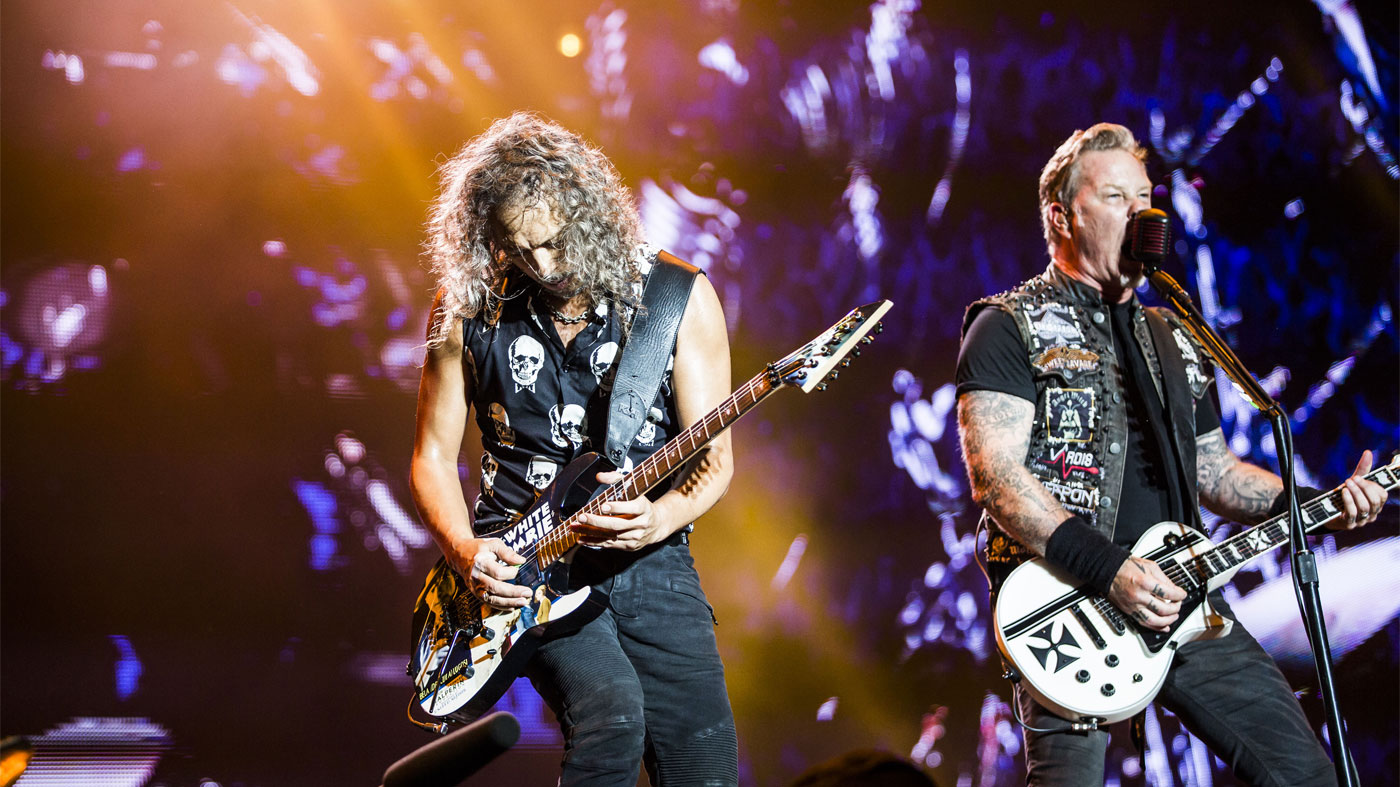
The springboard
It seems like this album was created over a long period of time, but it still sounds very cohesive. Did it all start to fall into place during the latter stages of recording?
James Hetfield: “It usually does. The road narrows, you know? You start with 800 riffs and you whittle it down to 50 with the help of others in the band. Then you pick ones you want to jam on.
There was a riff, it’s called The Parking Lot, and we thought that was an A+ riff and was going to end up as a song, but it never did
“I think it all kind of started with the [2014 song] Lords Of Summer when we were doing tons of Summer festivals. That was kind of the springboard because once you open that pandora’s box of riffs, you don’t want to stop. You start picking out stuff… actually in the movie [Metallica’s thriller/concert film hybrid, Through The Never] there were a couple of things that didn’t show up. There was a riff, it’s called The Parking Lot, and we thought that was an A+ riff and was going to end up as a song, but it never did. But it’s all springboarding.
“You narrow it down and start making some songs. I think when you say cohesive, that’s good, but to me they all started sounding the same after a while. We needed some variety, we need some slow stuff, some really fast stuff, so it took a little while.
“Mainly because of the time between albums, six to eight years and you’ve got a lot of material. And there’s also the part of me that wants to say, ‘Well fuck all that, let’s go and write some riffs now!’”
It seems like the song Hardwired came together pretty fast?
James: “Yes, that was the one where at the end [of the process] we stood back - which is tough to do sometimes after sporadically writing a record over two years - and said, ‘Oh wait a minute. We need to open this with something really in your face-style, so it was really easy and quick. And it was like, ‘We’ve got to do more of this stuff.’”
Here Comes Revenge is reminiscent of The Black Album-era sound. Was that a subconscious thing?
James: “I don’t think it was either overt or covert really. We sat there and were thinking, alright, Death Magnetic… what do we do after that? My take usually is shorter, more muscly songs and Lars claims a more organic approach [chuckles] where there’s no limit and you just keep writing. So between the two we get a little of both.
I wanted Kill 'Em All simplicity and a little more of the kind of misty layering and colourations of The Black Album
“I wanted Kill 'Em All simplicity and I also wanted a little more production than Death Magnetic with the kind of misty layering and colourations of The Black Album. So there’s a little bit in there at times, and then there’s some really, really simple stuff.”
Kirk Hammett: “I love that groove, I love the swing and the bounciness. For me the best rhythms to solo against are the rhythms that have a swing to them. As a guitar player I’m all about it - bring on the groove, bring on the swing. It just makes my job so much easier rather than soloing over a 5/8 time change and three chord changes within one bar. There’s a certain beauty to that, a type of art that’s being represented by that thinking.”
Dream No More even has a little pause before your solo that’s reminiscent of Sad But True…
Kirk: “Yes, it’s interesting that you say that because both those songs are in D tuning; maybe it’s something about being in D tuning that makes me play that way. But all this stuff, it just came out. It wasn’t really planned or anything, and I love that aspect of it.
The song Am I Savage sees a lot more of your blues influence come through tonally, too…
Kirk: “I’ve got this one guitar… its name is Greeny [Peter Green's 1959 Les Paul, which Kirk discusses at length in a previous interview]. I only have a couple of guitars that have actual names and one of them is The Mummy [KH-2] and one of them is Greeny. And when I have that guitar in my hands, there are certain licks that just want to come out. And for that solo, I don’t know if I played Greeny or not, but most likely had Greeny in my hands for warming up or was using it to play a solo and switched guitars, I’m not sure.
“But Greeny has a way of wanting me to play Peter Green and Gary Moore licks. It’s just one of those things. And the blues, the blues thing has always been with me since the very beginning, but I got really, really heavily into it in the 90s. But it’s really an example of how much of an effect that guitar has on me.”

Solo zone
What was your mindset when you went in to track the solos?
Kirk: “My guitar solos I’m still a little bewildered about. It was something I hadn’t done for a long, long time, to just go in there and play right off the top of my head - straight from the hip. There was very, very little that was worked out [beforehand], maybe eight per cent of the guitar solos were worked out on this album. If that. That’s a high percentage call!
I basically went in there and the only pre-planning I did was figuring out what key it was in and what would be the best scale to play
“I basically went in there and the only pre-planning I did was figuring out what key it was in and what would be the best scale to play. Maybe I could play a few arpeggios over this chord sequence. And that was it. I would just go in there and just go for it.
“Whether it was totally aggro and angry or melodic, soulful and mellow I just went for it. I had no idea what the outcome would be like with this approach but as I listen to the album as a whole, I’m really pleased with my lead guitar playing because for once it sounds unpredictable to me.
“When I listen to the guitar solos on our albums I pretty much knew sometimes six to eight months previous, maybe a year previous, exactly how the guitar solo was going to sound and what kind of solo it was going to be. It was always very predictable for me but this time around I listen to the stuff I did and I thought, ‘I couldn’t have planned that.’
“If you gave me six months time and said, ‘Right you have to play this particular lick and this phrase and it has to be this way… what I played on the album, there’s no way I could have planned it. For me all the notes are in those spaces and those places for a reason. And I had very little to do with the actually directing of traffic, I just let it flow.”
It’s really interesting to hear more twin harmony coming back into your sound on the album, especially Atlas Rise! - was that something you really wanted to explore again?
I love harmonies and Cliff Burton has planted a seed in me that continues to grow on that
James: “Absolutely. You know, if it was left up to me this album would be filled with that stuff! And a lot of melody. There was the triad of producers on this record - Greg Fidelman, Lars and myself. And those two kept saying, ‘There’s too much melody here’. And they would use their word which was, ‘It’s too pretty’ and I take as, a little too… they don’t want it to be perfect, I get that.
“But I love harmonies and Cliff Burton has planted a seed in me that continues to grow on that. And I love it. I always loved Thin Lizzy and bands that pull off these really cool harmonies. There’s so many cool voicings that you can do and it just interests me a lot.
“Kirk’s involvement on this record is solos only so I did all the melodies, the writing, the rhythm. Everything on this. So it is kind of easy to come up with stuff when you’re playing both parts.”
Kirk: “James and I, we’re big Thin Lizzy fans, so that whole guitar harmony thing is something we just love to break out. It’s fun playing harmonies, and I get to pretend that I’m Brian Robertson!”

Wah-wah land
Kirk, you used your new KHDK Dark Blood distortion pedal on the new album?
Kirk: “Yes, I did. It’s based on this one pedal I found in Europe… it’s weird, this pedal showed up, I bought it and I never saw another one ever again. I think they only made it for like six months or something. So I brought this pedal to Dave [Karon, Kirk’s business partner in KHDK] and said, ‘Dave, we need to break open this pedal and improve on it.’
“We basically did that. We improved on the voicing of it, and as a result, I have to say, as a lead guitar player, if you plug into that pedal it would be hard for you not to just want to instantly rip. It’s one of those pedals that if you plug into it, it just demands that you start playing a guitar solo.
“The way it’s voiced, it’s just a totally over-the-top pedal. Totally unique in its voicing and it’s all over the new album. Actually, all the pedals are all over the new album. Except for the Scuzz Box; that wasn’t out in time for it to be on the new album. But the other four are.”
In the footage of you recording the solo to Hardwired we were surprised to see three wahs on the floor. Is that a first for you?
Kirk: “Yes, but that was more a joke more than anything else; it didn’t really work out! [laughs] We just thought it was really hilarious that there were all these pictures and footage of me trying to hook up multiple wahs. But do you know what? It sounded like garbage!”
Do you ever leave a wah in a set position for tones like Michael Schenker used to?
Kirk: “Whenever I’ve tried that, I’ve always felt the need to step on the wah and start moving it around. Every time we’ve done that it just doesn’t work for me. I instinctively walk over to the wah and start moving it around; I can’t leave it in one position. I have to move it around - it’s just one of those things that happens with me.
“But having said that, though, I love the tone Michael Schenker gets on Obsession - that's what he did through that whole album; he cocked it in a certain spot.”
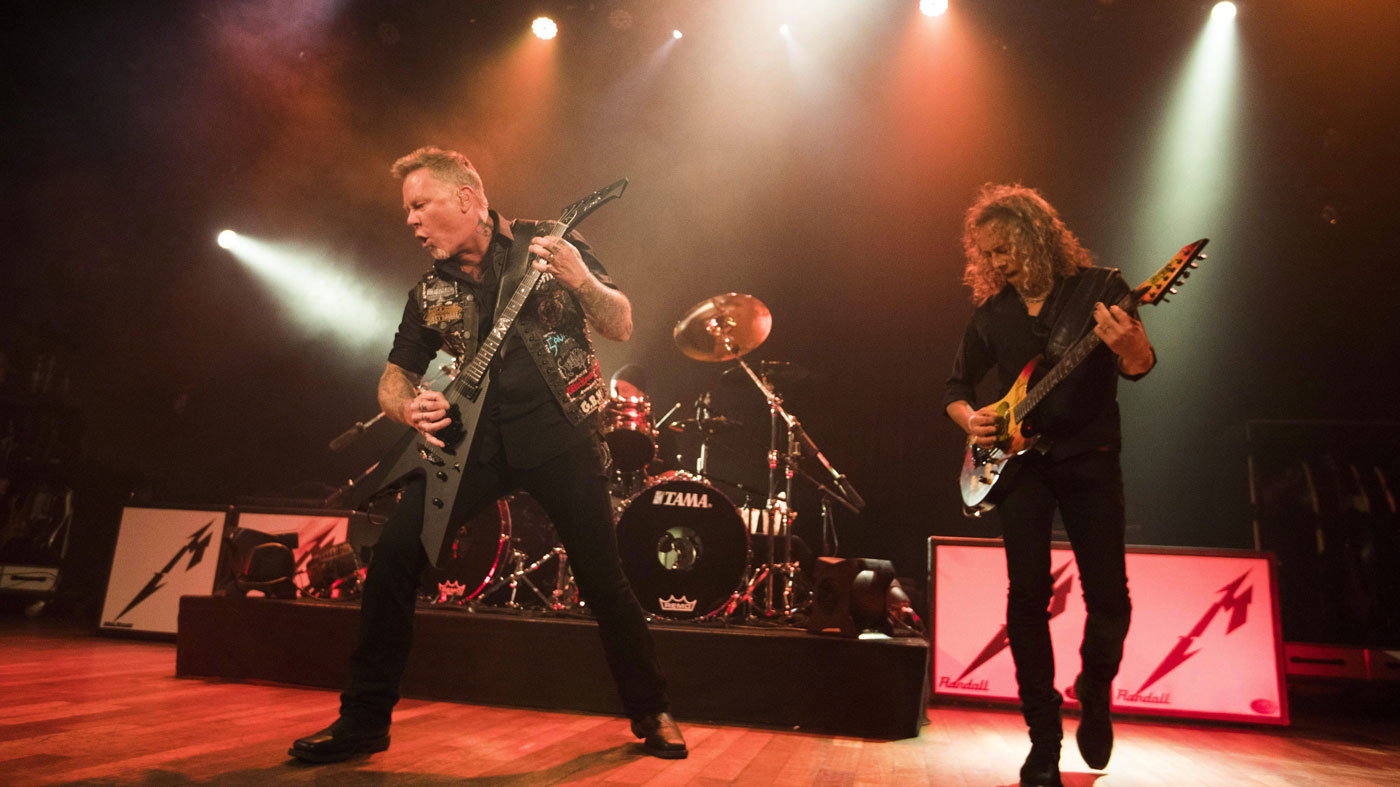
A punch in the midrange
The guitar tone has a real punch and clarity in the midrange. Is it difficult to strike a balance between that and the low end chug you need?
James: “Yes… the never-ending quest for the Holy Grail of guitar sounds. For me it’s got to be percussive. It’s got to push air, what we call bark. It’s got to bark. But I don’t want it really abrasive, so any fake fuzz to me really just takes away from the sound. And it’s tough because when you turn guitar sounds down, you really hear what they sound like and when you push them up it sounds a different way.
We’re trying to find that balance of enough mid push while still sounding big
“So we’re trying to find that balance of enough mid push while still sounding big and what I’ve found is the wider and bigger you make it sound the thinner it becomes in a way, at least depth-wise.
“You’ve got to find your space. Elbow your way in there and sonically make some room. And it varies throughout certain songs, the guitar is really important in this song but this one, maybe it’s all about groove. I think we’re learning to be a little more forgiving on each other’s need for volume [laughs] and look at the big picture.
“But I appreciate you saying that about the guitar sound because it is a work in progress still from Kill ’Em All on. The Crunch Berries amp that we’ve used, I think, since Ride The Lightning on or at least Master Of Puppets for sure. That Mesa/Boogie C++ [Simul-Class] is a very integral part of the sound still.”
Kirk: “And that’s a long name for an amp. They made very few of those Boogies and we happened to get a few. And those amps, along with EMG pickups were defining our sound. They enabled us to get the sound that we needed to get across. If it wasn’t for those Mesa/Boogie amps and EMG pickups, I don’t know how much further we would have got with just Marshalls.
“With the Boogies it was something different. Those Simul-Classes had three gain stages and a parametric EQ built in. The one great thing about that amp is how you cascaded the gain stages, there’s a particular order that you could run the gain stages to get a certain sound. And that’s what we liked about them. But then the Mesa/Boogie Dual Rectifiers came out, and for me it was a lot less knobs but a very similar sort of sound and gain.
“For me, who likes a simpler sort of set-up and approach, the Dual Rectifier actually worked better for me. It was great that James’s sound was defined by the Simul-Class because it enabled me to really latch on to the Dual Rectifier and have fun with that, explore that sound without us being too similar.”
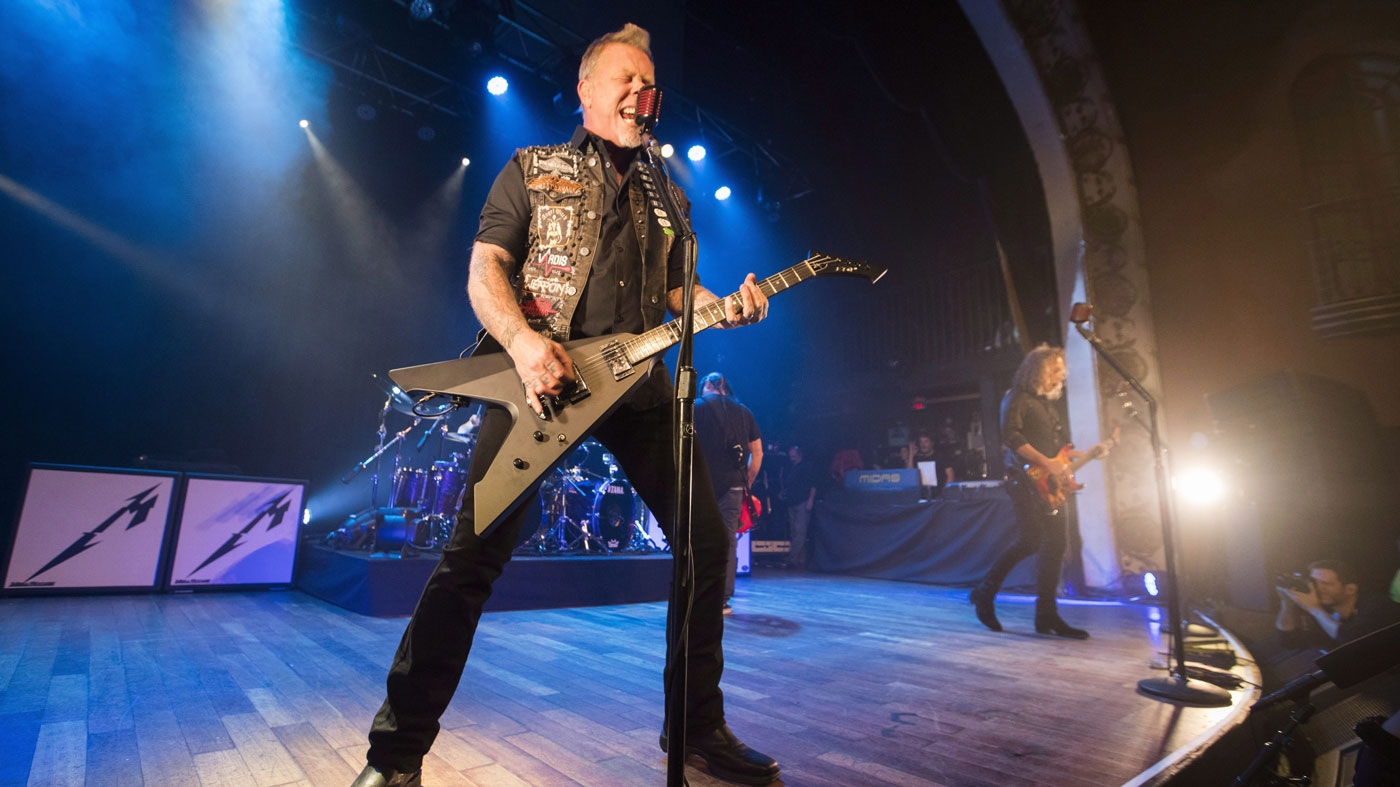
Meaty heads
What were your go-to amps when recording the album?
Kirk: “My Randall Kirk Hammett Meathead amp that I love, my Mesa/ Boogie and I have a 1979 Marshall head that’s been modified that I love to death, there was quite a bit of that dialled in, too. I have to say, I will always love that Marshall sound even though it’s been done to death.
The Ken Lawrence [Explorer] guitar that I have has always been the best sounding for clean
“There’s concurrent guitar tones on albums throughout the 70s, for a while everyone’s guitar sounded the same in the 70s and it’s because everyone was using the same equipment. But I have to say for an aggressive guitar sound, Marshall does it, man. I love that Marshall sound and always will. Even though I strive to do original things all the time that Marshall sound is just something I have a long running love affair with.”
What about the clean tones for songs such as Halo On Fire, do you use a specific guitar for tracking?
James: “If you walk into the control room where I’m actually sitting now, it’s like a music store. You walk in and there’s about 20 guitars hanging on the wall so at any point I can just pull one down and say, ‘This one plays really easy, but how does it sound?’ so we strike a nice balance.
“The Ken Lawrence [Explorer] guitar that I have has always been the best sounding for clean, though since I’ve done the [EMG signature] Het Set, that neck pickup is really, really clear. So any of the guitars would sound okay with it. But it’s a blend, that [Roland] JC-120 has been the go-to forever for me. That is my favourite clean amp, but mixed in with a few other things. Amps that Greg brings in. So it is a blend of a few things. But the clean sound is just as important as heavy, at least in my rig.”
And were you plugging in your old Kill 'Em All white Electra V again a lot like you did on Death Magnetic?
James: “Yes. It’s really good for the faster songs. Saying, ‘This guitar is really fast’ sounds stupid but it is. This guitar is really fast and easy to play, maybe because I’ve played it for 35 years! It is like an old pair of shoes, you put it on and it’s so comfortable.
“So it was between that and the main guitar on this one, which is what we’re calling the Copperhead. It’s a Snakebite with the Het Set in it. It’s got a paint job to it that Bill Nash did who relics a lot of my stuff and I don’t know why, because the pickups are painted, everything is painted on it, you’d think it would dull it and make it terrible but it just works. So that was the main guitar, with the V and the old ESP, the ‘Eet Fuk’.”
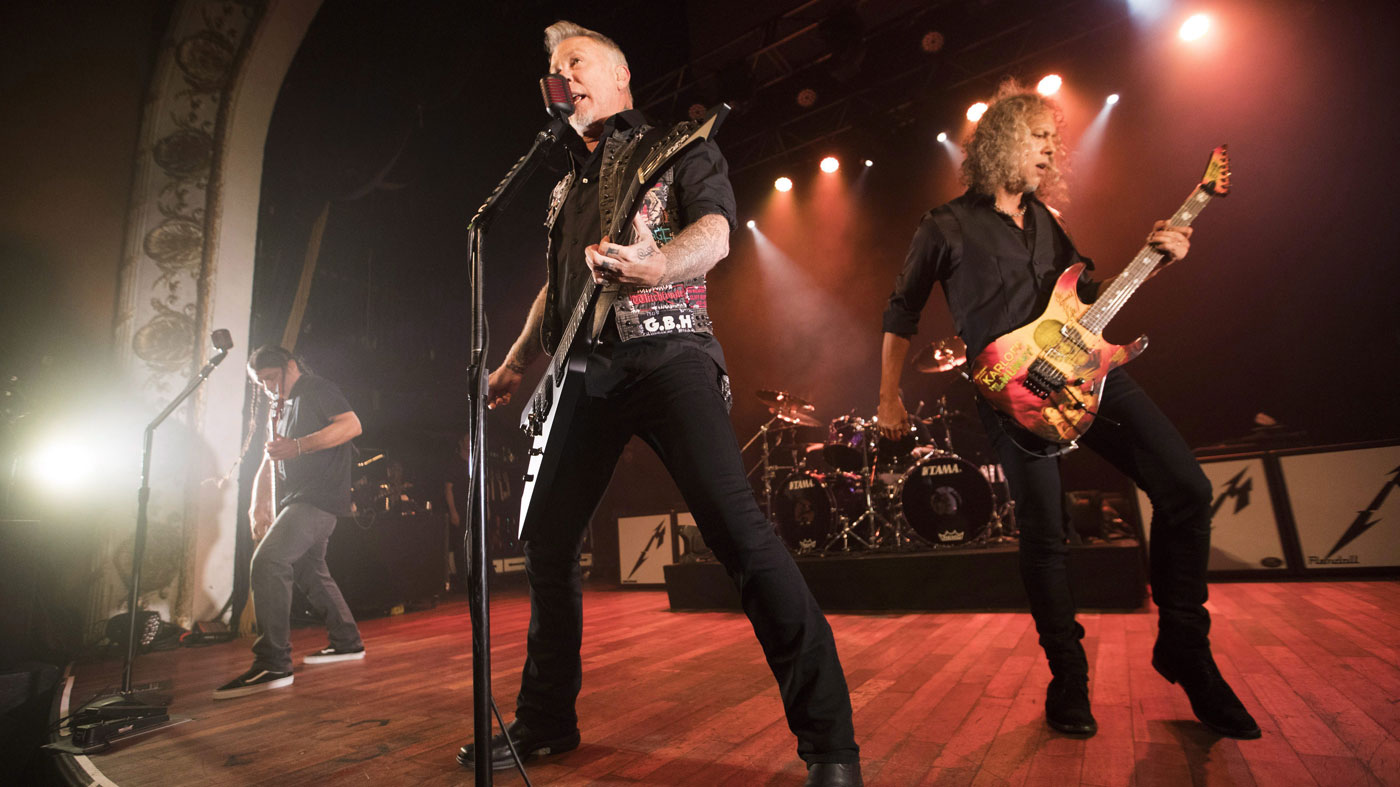
Unsaturated, phat
You’ve taken saturation out of your gain over time, how has that affected your rhythm playing - did you have to dig in harder with your downpicking?
James: “Yes, and once you start digging in harder your strings are taking abuse, your pick takes abuse. So the Black Fang that I worked with Dunlop on for quite a while, it took quite a few incarnations of it and between the point that’s on there and the material they do definitely last longer.
It’s like a stew, you throw all these things in and you think it’s going to taste like this and then it ends up like something else
“I would say digging in, I think it’s a positive thing. It gives it a little bit more dynamic and it’s not so compressed and saturated that there’s no dynamic to it. But most of it was for facial value - wanting to cut through. It’s about finding that right blend.
“Sometimes I feel, wow it’s too clean and I’m working too hard. Other times, it’s too saturated and I can’t actually hear the note and it kind of messes with my vocal a little bit. If I can’t hear the note clearer, especially with fast stuff, I want to be clear so you can feel the percussiveness of it.”
Some of your parts are obviously challenging to play and sing together. Do you bring the vocal idea in early on in the writing to make that easier, or do you focus on the guitar idea first?
James: “It’s the latter, but it works both ways. If I go out there and just play the riff stuff and I get that really cool sounding and hey, we’ve got this complicated little thing. And then I think, ‘Oh shit I’ve got to sing over it.’
“I’ll want to make it really easy and I don’t like that. I’ll challenge myself to slow the whole thing down and sing over whatever I’ve played. And make it as close as possible to it.
“Over time when we rehearse these songs, yes the vocal changes a little bit because you want to impact a certain hit on your guitar or vice versa, so it’s like a stew, you throw all these things in and you think it’s going to taste like this and then it ends up like something else so the singing and the playing is its own thing.”
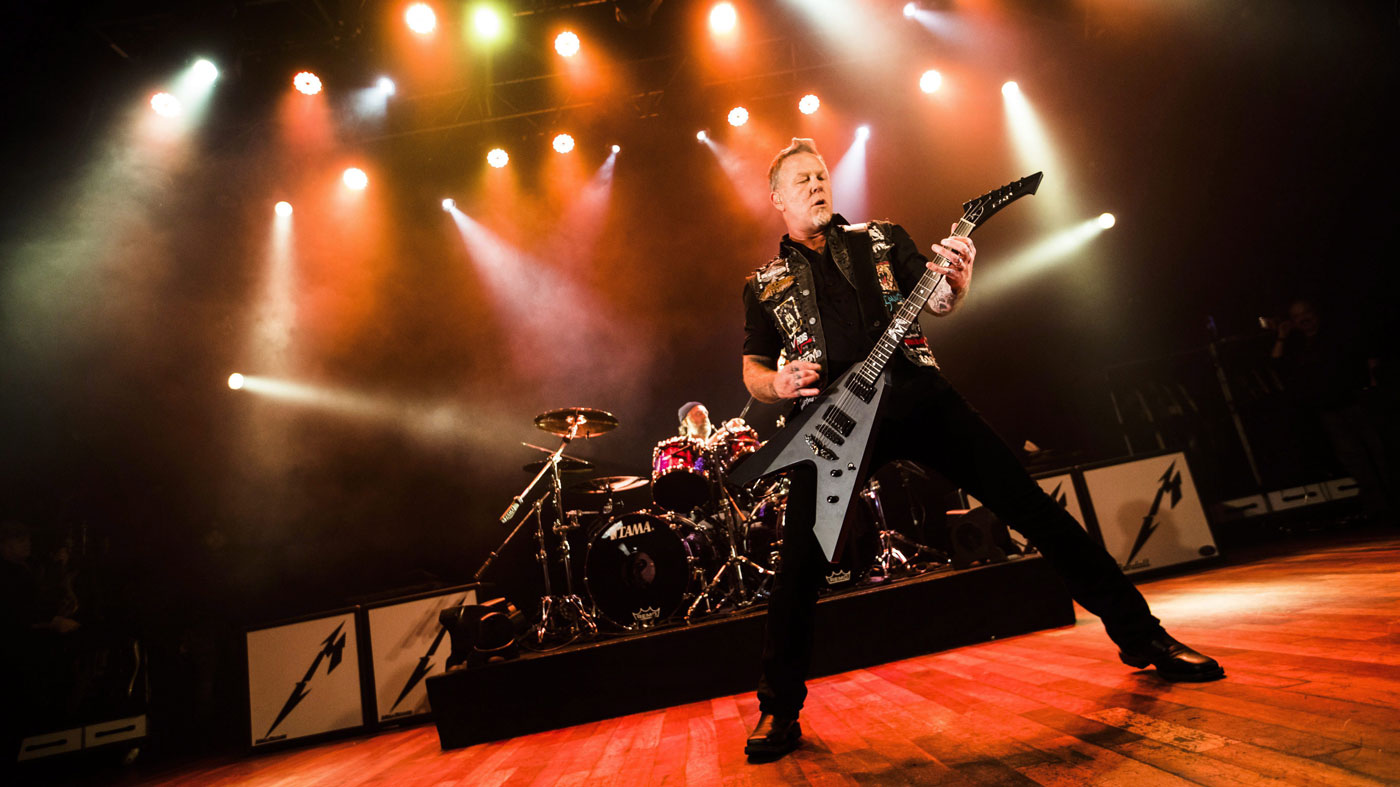
Master of picking
You’ve always been creative with standard tuning but a lot of metal bands tune down. Do you think you have to be really consider the riffs you’re creating when you’re in standard, and the kind of heavy feel you’re getting from them?
James: “With tuning down it’s easy to make it sound dark and sinister. There are definitely bands that stay in that tuning all the time, and that can become limiting as well. But I think sonically it makes it less lively. I know there are bands that do it extremely well. For us, there’s one song on this record that’s, I don’t think it’s dropped but it’s tuned down a bit just to help the riff.
“Again, it’s not a black and white thing. Certain songs call for it and certain songs don’t. So it’s not challenging because I think when the strings are tighter and you’re up there, it’s a little easier to play faster or get a tone, a clearer tone out of it.”
Understandably, a lot of players look up to you as a rhythm player. Did that strength and development in your technique come fairly naturally early on or did it feel like a lot of practice work went into it?
The percussiveness and the downpicking, that’s something that just came through competition
James: “It’s impossible to call it work, it really is. It’s just a joy and a passion. When I pick up the guitar… I want to be the drummer. I’ve always loved playing drums, so it’s kind of what I’m doing on the guitar. I love syncopation, just unique drum beats so I’ve always incorporated that in. The percussiveness and the downpicking, that’s something that just came through competition, really. ‘Hey, these guys are faster; I’m going to be faster!’ Goofy guy stuff like that, but at the end of the day it has its own sound. It’s like hitting a drum, it really is.
“There have obviously been influences that have shaped it somewhat. Listening to Scorpions… [Rudolph Schenker], I like that he’s just the rhythm guy. He’s not trying to be everything and he’s the best at what he did. At the time he was really percussive in a way. So yes, quite a few people have influenced it, but a lot of it is the drums.”
There’s not really a fast track to building up your downpicking strength, but do you have any advice?
James: “I’d say the key is hanging out with another guitar player that feels the same, and you’ll push each other.”
Something that really stands out on this record is the versatility of your voice, and it sounds like you’re going into the higher ranges really confidently and sounding strong. Is that something you’ve been consciously working on?
James: “Well, you know what’s weird is I think people have their own likes and dislikes in a singer, but I think the general theory is if you have a big range you’re a good singer. And I don’t necessarily believe that, but I don’t want to phone it in.
“It's easy to stay in your range, and it’s easy to stay in a certain key. And I just feel boxed by it and it kind of frustrated me, so I wanted to break out of that box again and get into D and B and C and G, instead of just hanging in E all the time, you know? But especially around this album, we were recording in true 440 [standard tuning] so the tuning is back to Kill 'Em All and that has challenged me a little bit, but it does; it lifts it in a way.
“And I think another key thing was when we did the Ronnie Dio tribute record. We did this medley of a bunch of different Dio songs and I just realised how fucking amazing that guy was. And it pissed me off, because when I met him I said, 'Hey, can I hear your warmup tape? What do you do - what’s your secret to all of this?' And he said, ‘Well, I just have a little glass of wine and go out and sing.’ What?! Yeah right! But I don’t think he was BS’ing me; he was just a natural singer and he had a range that had power all the way through it, and he just continues to challenge me which is great.”
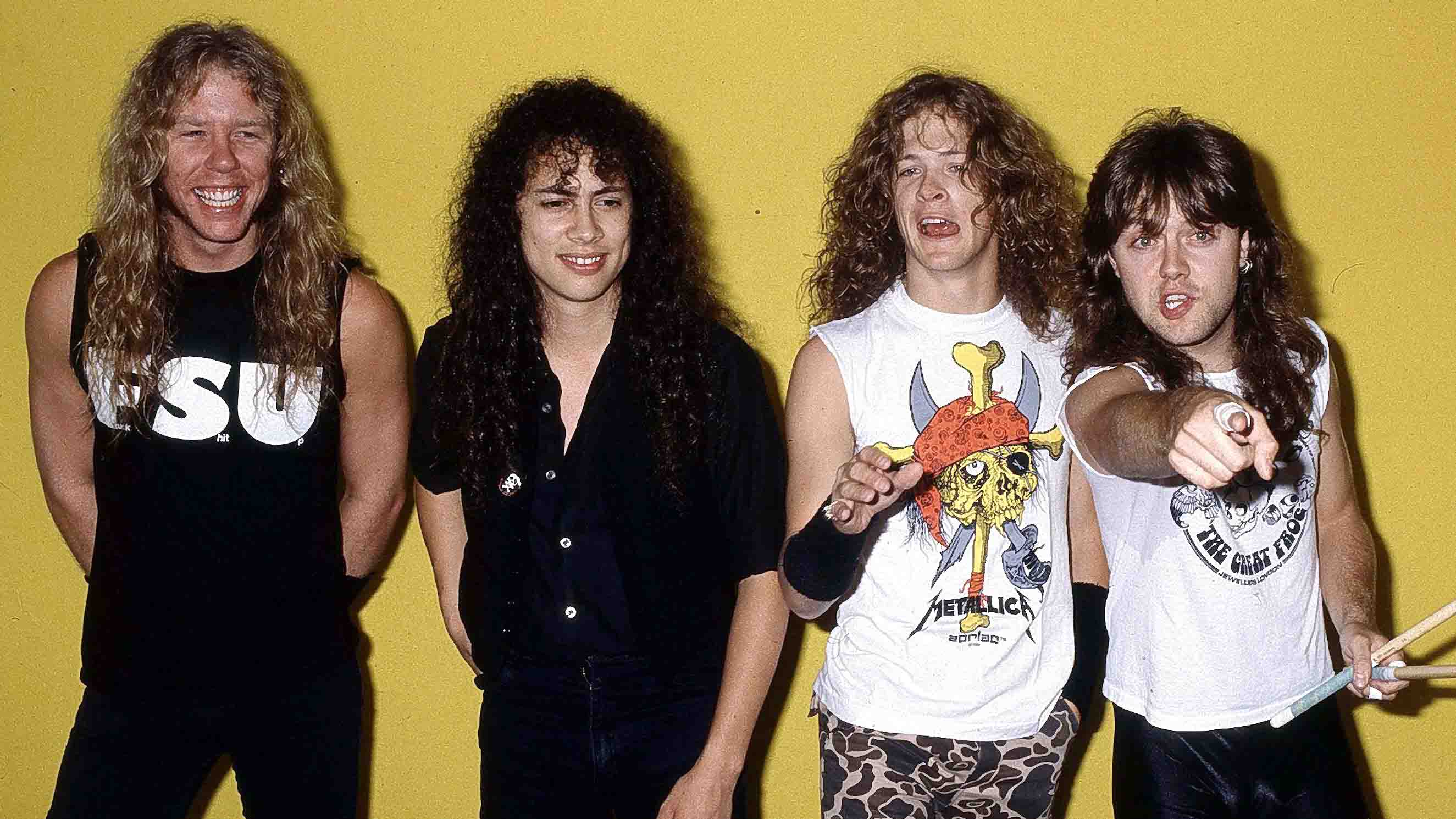
Justice days… revisited
What’s it been like for you going through the process of releasing the reissues of Kill Em All, Ride The Lightning and Master Of Puppets, hearing those eras of your tone?
James: “It’s great to revisit the history of your evolution as a guitar player, as a singer and, I guess, a wannabe producer [laughs]. And the sound has definitely changed: one, it’s changed because of what amp could we afford, what did I have… stuff like that.
“Kill 'Em All was very minimal, but when I sit and I listen to it there’s a real beauty to that sound. It’s certainly not percussive in the way I think percussive is now. It’s more of a high-mid, mid-crunch that I think fits that really well. It just sounds young and, I guess, inexpensive! [laughs]”
…And Justice For All will inevitably be the next reissue, and was an interesting album for your tone because it sent a lot of players searching for that scooped sound afterwards. How do you feel about it looking back?
We were pretty ear-fatigued… There’s a lot more high-end and it had to cut through our deaf ears at that point
James: “I know there’s quite a few people that love that record; there’s a real punchiness to it, and because it’s somewhat progressive, that does fit with it a bit. You can hear things a little better. Obviously there’s not much depth to it as far as thickness goes and, you know, it is what it is because that’s Lars and I trying to venture into producing ourselves and discovering… well, you can tell who produced it because the guitars and the drums and the vocals are really loud.
“But, to be honest, I’ve got to cut ourselves some slack because when we were mixing that record, we were right in the middle of doing the Monsters Of Rock tour. So we started off on the East Coast, we were mixing it there and it was easy at the beginning, but once the tour started moving further west we were travelling a lot.
“On a day off, Lars and I would fly… well, fly or drive. Most of the times, drive. I remember at the time limos were a big deal and it actually had leg room for me. Sleeping on an eight-hour drive in a limo to wherever from somewhere in Iowa or wherever when we were mixing this thing in upstate New York. So we were pretty fatigued, ear-fatigued as well. That’s a big factor in it, I think. There’s a lot more high-end and it had to cut through our deaf ears at that point.”
What are your memories of recording the lead guitars for …And Justice For All?
Kirk: “It’s interesting, because when we were recording that album I really didn’t have as much time to do the solos as I’d wanted to. And time was running out, literally. I think we had to leave for the Monsters Of Rock Tour on a Saturday and it was Thursday but we were still recording guitar solos.
“I can remember showing up at 10 or 11 in the morning and working on solos and that leading to two or three o’clock in the morning the next day. It was just ridiculous: 15 or 16 hours of recording. And I had four or five days of that.
My fingers and hands were so fatigued that I had trouble bending a note in key to another note
“The one thing that sticks out the most for me, as far as what was challenging for me is I remember the guitar solo for Harvester Of Sorrow and I remember I was so tired, it was so late at night and my fingers and hands were so fatigued that I had trouble bending a note in key to another note.
“And I remember Flemming [Rasmussen, producer] saying, ‘Okay, just bend it this much. Just bend it a half-step and I’ll take it up with the harmoniser for the other half-step.’ And I remember thinking to myself, 'Is this really necessary, or can we just stop and do it all over again properly tomorrow?' But there wasn’t a tomorrow. We had to do it that way.”
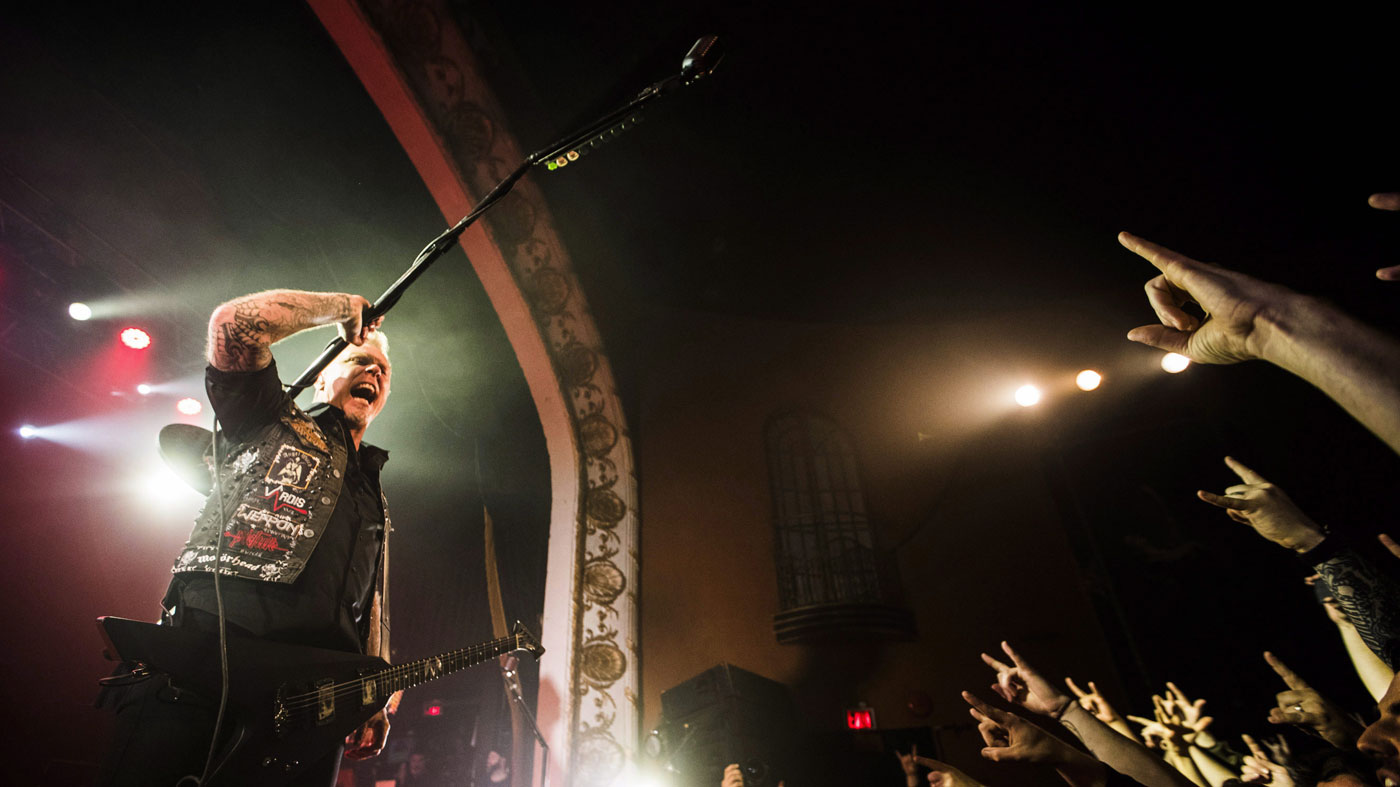
Life with Lars
Some people don’t realise how crucial Lars’s role is in the Metallica songwriting process. How do you think he’s influenced you as guitar players?
Kirk: “He gives me objectivity where I have none. I’m like every other guitar player, everything I play is so tremendously great! That’s how all guitar players are, right? Everything that you play is, obviously, or else you wouldn’t be playing it [laughs]. Lars is good at giving me a different opinion.”
James: “He is very important if I’ve got 800 riffs and they’re all great so I need some kind of filter. And he’ll come in and he’ll pick out the stuff. He’s a good finder of riffs and he hears things different than I do.
“When we go to do certain songs he’ll be playing on the offbeat in my mind and he’s on the onbeat in his. So it’s a great problem to have that we hear things differently. There’s a very creative grind that happens with that and it can go off the rails but most of the time it’s extremely worth it because you’re coming up with some really cool stuff. And we’ll go out and jam on it.
Lars wants to be the singer and guitar player, I want to be the drummer so it’s really kind of odd but cool [as writers]
“What happens next? We just let it happen and then usually a feel happens. He plays it on drums or I do it with a riff and I’ll tell you, we help each other a lot. He wants to be the singer and guitar player, I want to be the drummer so it’s really kind of odd but cool where we make little suggestions that the other wouldn’t even think of.”
Metallica’s new album, Hardwired... To Self-Destruct, is out now on Blackened.
Don't Miss
Dave Mustaine reviews Metallica's Hardwired… To Self-Destruct
Kirk Hammett on owning Peter Green's 1959 Gibson Les Paul: "It just blew me away"

Rob is the Reviews Editor for GuitarWorld.com and MusicRadar guitars, so spends most of his waking hours (and beyond) thinking about and trying the latest gear while making sure our reviews team is giving you thorough and honest tests of it. He's worked for guitar mags and sites as a writer and editor for nearly 20 years but still winces at the thought of restringing anything with a Floyd Rose.

